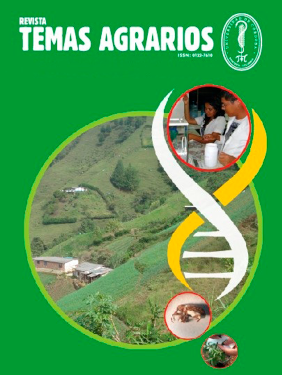Analisis del desarrollo textural de carbones activados preparados a partir de zuro de maíz
Analysis of development textural activated carbon from zea mays

Esta obra está bajo una licencia internacional Creative Commons Atribución-NoComercial 4.0.
Mostrar biografía de los autores
Algunos residuos agrícolas pueden ser útiles para producir materiales adsorbentes como son los de carbones activados. Tal es el caso del Zuro de maíz, el cual fue utilizado como material de partida en esta investigación, Para la preparación de carbón activado, inicialmente el zuro libre de granos de maíz es carbonizado a temperatura de 400 °C, posteriormente los carbonizados fueron activados químicamente con ácido ortofosfórico, los carbones activados obtenidos fueron modificados con ácido nítrico y peróxido de hidrógeno, previo calentamiento a 600°C para observar su desarrollo textural. Los sólidos fueron caracterizados a través de un análisis, para la determinación del área superficial se realizaron isotermas de adsorción mediante el método BET, utilizando equipo Micromeritics Gemini 2375. La activación con ácido ortofosfórico aumentó el contenido de carbono y disminuyó el contenido de oxígeno. El área de microporos se incrementó por el tratamiento con HNO3 y H 2O2 desde 278,3 m2 g-1 hasta 401,7m2 g-1 y 446,4 m2g-1 respectivamente y la mayor parte del área total desarrollada correspondió a microporos. El pH generado por los carbones fue aproximadamente 3, el cual se determinó en soluciones acuosas luego de lavado con agua destilada; así mismo, estos materiales mostraron valores en los grupos COOH hasta 2,12 meq g-1.
Visitas del artículo 1033 | Visitas PDF
Descargas
- Allen, S., Whitten, L. 2008. The production and characterization of activated coals: A
- Review. Asia-Pac. J. Chem. Eng. 6:231-261.
- Amalraj, A., Pius, A. 2014. Removal of selected basic dyes using
- activated carbon from tannery wastes. Sep. Sci. Technol. 49: 90- 100.
- Arpa, C., Basyilmaz, E., Bektas, S., Genc, O., & Yurum, Y. 2000. Cation exchange properties of low Turkish coals: removal of Hg, Cd and Pb from wastewater. Fuel Processing Technology 68(2):111-120.
- Berkowitz, N. 1957. On the differential thermal analysis of coal. Fuel 36:355-373
- Boehm, H.P. 1994. Some aspects of the surface chemistry of carbon blacks and other carbons. Carbon 32(5):759 -769.
- Burns, C.A., Cass, J., Harding, I., Russell, H. 1999. Adsorption of aqueous heavy metals onto carbonaceous substrates. Colloids and Surfaces A155:63-68.
- Castilla, M., López-Ramon, M.V., & CarrascoMarin,F. 2000. Changes in surface chemistry of activated carbons by wet oxidation.Carbon 38(14):1995-2001.
- Garoma, T., S., Shah, B., Badriyha. 2010. Removal of Cadmium, Copper, and Zinc from Aqueous Solution by Activated Carbon Impregnated with 8-Hydroxyquinoline. J Environ Sci Eng 4(5):14-21.
- González, J., Román, S., Encinar, J., Martínez, G. 2009. Pyrolysis of various biomass residues and char utilization for the production of activated carbons,” J. Anal. Appl. Pyrolysis, 85(1-2):134-141.
- Hsisheng, T., Yeh, T.S., & Hsu, L-Y. 1998. Preparation of Activated Carbon from Bituminous Coal with Phosphoric Acid Activation. Carbon 36(9):1387-1395.
- Huidobro, A., Pastor, A.C., & Rodríguez-Reinoso, F. 2000. Preparation of activated carbon cloth from viscous rayon. Part IV. Chemical activation.Carbon 39(3):389-398.
- Kim, D., Y. W., Jung, S., Kwon, J-W., Park. 2011. Adsorption of cadmium (II) from aqueous solutions by thiol-functionalized activated carbon. Water Sci. Technol.: Water Suppl. 11(1):61-66
- Kudo, K., & Yoshida,E. 1957. On the decomposition process of wood constituents in the course of carbonization. Journal of the Japanese Wood Research Society 3 (4):125-127.
- Li, Y., Q., Dua, X., Wang, P., Zhang, D., Wang, Z., Wang, Y., Xia. 2010. Removal of lead from aqueous solution by activated carbon prepared from Enteromorpha prolifera by zinc chloride activation. J Hazard Mat 183(1-3):583-589.
- López-Ramón, M.V., Stoeckli, F., MorenoCastilla, C., & Carrasco-Marín, F. 1999. On the characterization acidic and basic surface sites on carbons by various techniques. Carbon 37(8):1215- 1221.
- Mak, S., Tey, B., Cheah, K., Siew, W., Tan, K.2009. Porosity characteristics and pore developments of various particle sizes palmkernel shells activated carbon (PKSAC) andits potential applications. Adsorption 15: 507-519
- Marsh, H., Heintz, E.A., & Rodríguez-Reinoso, F.1997. Introduction to Carbon Technology.Capítulo 2.Universidad de Alicante.Alicante, España: Secretariado de Publicaciones.
- Navarrete, L., Giraldo, L., Baquero, M. 2005. Carbón activado: efecto del lavado con ácido sulfúrico del precursor lignocelulósico, cuesco de palma africana, sobre los procesos de carbonización y activación. Rev. Colombiana de Quím. 34:67-78.
- Ospina, V., Buitriago, R., Lopez, L. 2014. Preparación y caracterización de carbón activado a partir de torta de higuerilla. Tecno Lógicas 17(32):75-84.
- Primera, O., Colpas, F., Meza, E., Fernandez, R. 2011. Carbones activados a partir de bagazo de caña de azúcar y zuro de maíz para la adsorción de cadmio y plomo. Rev. acad. colomb. cienc. exact. fi. nat. 35(136): 387.396.
- Rodríguez-Reinoso, F. & Molina-Sabio,M. 1998. Carbones activados a partir de materiales lignocelulósicos. Química e Industria 45(9):563-571.
- SCFI (Secretaria de Comercio Fomento Industrial). 1982. Norma mexicana NMX-B-158-1982, Métodos para determinar el azufre total en la muestra de carbón y coque. http://200.77.231.100/work/normas/ nmx/1982/nmx-b-158-1982.pdf.
- Song, X., Liu, L., Chenga, & Y., Qu. 2010. Surface modification of coconut-based activated carbon by liquid-phase oxidation and its effects on lead ion adsorption. Desalination 255(1- 3):78-83.
- Tongpoothorn, W., Sriuttha, P., Homchan, S.,Chanthai, C., Ruangviriyacha. 2011. Preparation of activated carbon derived from Jatropha curcas fruit shell by simple thermochemical activation and characterization of their physicochemical properties. Chem Eng Res Des 89(3):335- 340.
- Valix, M., Cheung, W.H., Zhang, K. 2008. Textural and surface chemistry of activated bagasse and its role in the removal of chromium ions from solution. Adsorption 14:711-718.
- Wu Z, Zhao D. 2011. Ordered mesoporous materials as adsorbents. Chem Commun; 47:3332–8.
- Yu C, Fan X, Yu L, Bandosz TJ, Zhao Z, Qiu J. 2013. Adsorptive removal of thiophenic compounds from oils by activated carbon modifid with concentrated nitric acid. Energy Fuel .27:1499–505.
- Zhang, H., Yan, Y., Yang, L. 2010. Preparation of activated carbon from sawdust by zinc chloride activation. Adsorption 16:161-166.




















